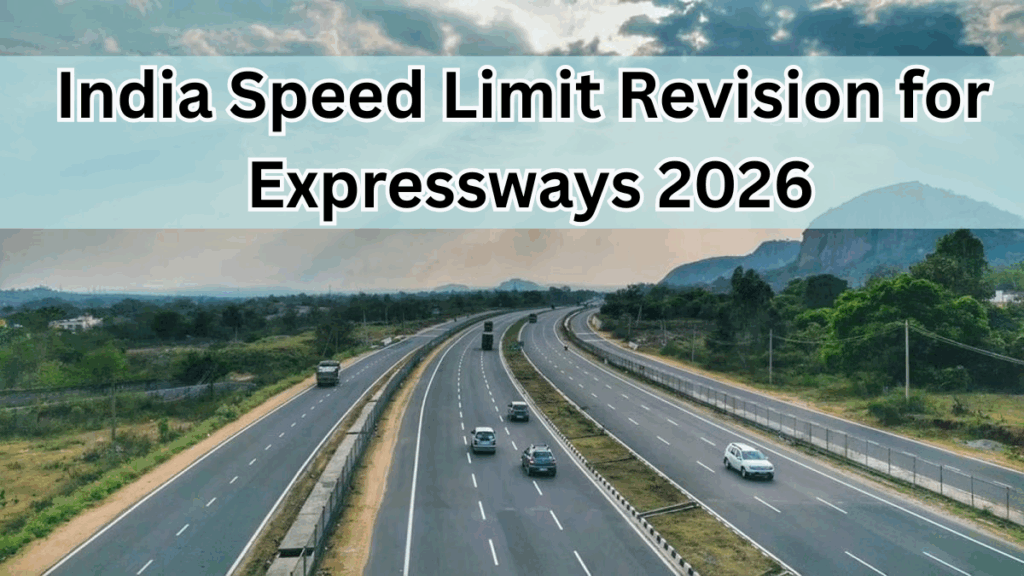India is all set to introduce new traffic norms under the India Speed Limit Revision for Expressways 2026. As expressways continue to evolve with better engineering and safety features, it’s only fitting that speed regulations also catch up. This new move aims to ensure faster, safer, and more efficient travel for everyone on the road.

What’s Changing in 2026?
The expressway speed limit 2026 brings higher speed allowances for several vehicle categories. Here’s a clear look at the changes coming your way.
Updated Speed Limits by Vehicle Type
| Vehicle Category | Old Speed Limit (km/h) | Revised Limit (2026) |
|---|---|---|
| Private Cars | 100 | 120 |
| Motorcycles | 80 | 100 |
| Heavy Commercial Vehicles (HCVs) | 80 | 100 |
| Buses | 80 | 100 |
| Emergency Vehicles | No fixed limit | Dynamic (AI-monitored) |
Why the Revision Was Necessary
The India Speed Limit Revision for Expressways 2026 isn’t just about speed. It’s about modernization, safety, and optimizing India’s transport infrastructure.
-
Better roads with six-lane expressways and smart corridors
-
Improved vehicle safety features like ABS, ESC, and airbags
-
Faster commuting demands due to urban expansion
-
Reduction in traffic congestion and bottlenecks
Stricter Fines Under the New Rules
As part of the India new rules, authorities will introduce tougher fines and penalty points for those violating the speed limits on expressways.
Fine and Penalty Details
| Offense | Fine Amount | Penalty Points |
|---|---|---|
| Overspeeding (up to 20 km/h over) | ₹1,000 | 2 points |
| Overspeeding (20+ km/h over) | ₹2,000 – ₹4,000 | 3–5 points |
| Repeat Offense | Up to ₹10,000 | 6 points + suspension |
Smarter Enforcement with Technology
To effectively implement the expressway speed limit 2026, the government will rely on digital and AI-powered tools:
-
Smart cameras for automatic speed detection
-
AI-based monitoring for dynamic limit zones
-
FASTag integration for instant violation notifications
-
Digital driver scorecards via road safety portals
Benefits of the New Speed Limits
The India Speed Limit Revision for Expressways 2026 is expected to benefit commuters and businesses alike.
-
Reduced long-distance travel time by 20–30%
-
Improved fuel efficiency for commercial fleets
-
Lower carbon emissions from smoother traffic flow
-
Safer high-speed travel with stricter lane discipline
FAQs
Q1: When will the new speed limits come into force?
The India Speed Limit Revision for Expressways 2026 will officially roll out on April 1, 2026, covering all national expressways.
Q2: Will the new limits apply to state highways or city roads?
No, these speed limits apply strictly to national expressways. Other roads will continue with existing or state-notified limits unless changes are announced.
Q3: How will violations be tracked and penalized?
Violations will be monitored using AI-powered cameras and FASTag-linked systems. Offenders will receive instant alerts and fines digitally.
Q4: Can drivers choose to drive slower than the new limits?
Yes, the new speed limits are maximum thresholds. Drivers can operate at a comfortable and safe speed depending on their vehicle condition, traffic, and weather.
Final Thoughts
The India new rules on speed limits signify a major leap in aligning India’s road policies with international standards. The expressway speed limit 2026 initiative balances speed with safety, offering a smarter, faster, and more disciplined driving experience for Indian road users.
Click here to learn more
